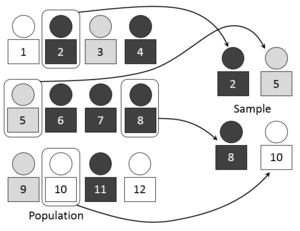Sample (statistics)
In statistics and quantitative research methodology, a data sample is a set of data collected and the world selected from a statistical population by a defined procedure.[1] The elements of a sample are known as sample points, sampling units or observations[citation needed].
Typically, the population is very large, making a census or a complete enumeration of all the values in the population either impractical or impossible. the sample usually represents a subset of manageable size. Samples are collected and statistics are calculated from the samples, so that one can make inferences or extrapolations from the sample to the population.
The data sample may be drawn from a population without replacement (i.e. no element can be selected more than once in the same sample), in which case it is a subset of a population; or with replacement (i.e. an element may appear multiple times in the one sample), in which case it is a multisubset.[2]
Contents
Kinds of samples[edit]
A complete sample is a set of objects from a parent population that includes ALL such objects that satisfy a set of well-defined selection criteria.[3] For example, a complete sample of Australian men taller than 2m would consist of a list of every Australian male taller than 2m. But it wouldn't include German males, or tall Australian females, or people shorter than 2m. So to compile such a complete sample requires a complete list of the parent population, including data on height, gender, and nationality for each member of that parent population. In the case of human populations, such a complete list is unlikely to exist (the human population being in the billions). But, such complete samples are often available in other disciplines such as the set of players in a major sports league, the birth dates of the members of a parliament, or a complete magnitude-limited list of astronomical objects.
An unbiased (representative) sample is a set of objects chosen from a complete sample using a selection process that does not depend on the properties of the objects.[4] For example, an unbiased sample of Australian men taller than 2m might consist of a randomly sampled subset of 1% of Australian males taller than 2m. But one chosen from the electoral register might not be unbiased since, for example, males aged under 18 will not be on the electoral register. In an astronomical context, an unbiased sample might consist of that fraction of a complete sample for which data are available, provided the data availability is not biased by individual source properties.
The best way to avoid a biased or unrepresentative sample is to select a random sample, also known as a probability sample. A random sample is defined as a sample where each individual member of the population has a known, non-zero chance of being selected as part of the sample.[5] Several types of random samples are simple random samples, systematic samples, stratified random samples, and cluster random samples.
A sample that is not random is called a non-random sample or a non-probability sampling.[6] Some examples of nonrandom samples are convenience samples, judgment samples, purposive samples, quota samples, snowball samples, and quadrature nodes in quasi-Monte Carlo methods.
Mathematical description of random sample[edit]
In mathematical terms, given a probability distribution F, a random sample of length n (where n may be any positive integer) is a set of realizations of n independent, identically distributed (iid) random variables with distribution F.[7]
A sample concretely represents the results of n experiments in which the same quantity is measured. For example, if we want to estimate the average height of members of a particular population, we measure the heights of n individuals. Each measurement is drawn from the probability distribution F characterizing the population, so each measured height is the realization of a random variable with distribution F. Note that a set of random variables (i.e., a set of measurable functions) must not be confused with the realizations of these variables (which are the values that these random variables take). In other words, is a function representing the measurement at the i-th experiment and is the value obtained when making the measurement.
See also[edit]
- Estimation theory
- Replication (statistics)
- Sample size determination
- Sampling (statistics)
- Survey sampling
Notes[edit]
- ^ Peck, Roxy; Chris Olsen; Jay L. Devore (2008). Introduction to Statistics and Data Analysis (3 ed.). Cengage Learning. ISBN 0-495-55783-8. Retrieved 2009-08-04.
- ^ Borzyszkowski, Andrzej M.; Sokołowski, Stefan, eds. (1993), Mathematical Foundations of Computer Science 1993. 18th International Symposium, MFCS'93 Gdańsk, Poland, August 30–September 3, 1993 Proceedings (PDF), Lecture Notes in Computer Science, 711, pp. 281–290, doi:10.1007/3-540-57182-5_20, ISBN 978-3-540-57182-7, Zbl 0925.11026
- ^ Pratt,g J. W., Raiffa, H. and Schaifer, R. (1995). Introduction to Statistical Decision Theory. MIT Press, Cambridge,MA. MR1326829
- ^ Lomax, R. G. and Hahs-Vaughan, Debbie L. An introduction to statistical concepts (3rd ed).
- ^ Cochran, William G. (1977). Sampling techniques (Third ed.). Wiley. ISBN 0-471-16240-X.
- ^ Johan Strydom (2005). Introduction to Marketing (Third ed.). Wiley. ISBN 0-471-16240-X.
- ^ Samuel S. Wilks, Mathematical Statistics, John Wiley, 1962, Section 8.1



